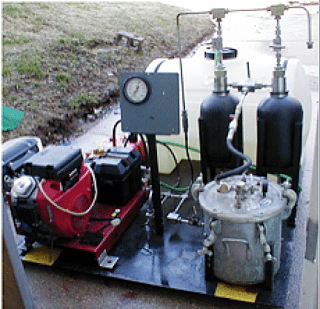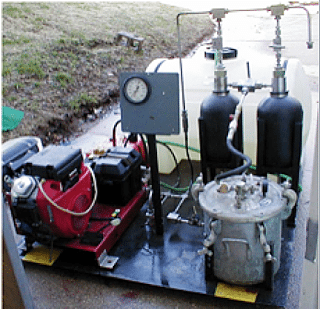In these cases, choice of the best strategies to remove the central core of material from the hole varies, depending in part on how large the hole is, and in what sort of material. For relatively small diameter holes, then the jet itself can drill a hole large enough for the head to enter the target. (In part this is because the diameter of the nozzle and supporting pipe can either be made quite small, or the jet can be made more diffuse.) In other cases the cutting head has to be designed to remove that central volume in a way that allows the fragments to pass the nozzle assembly as it feeds down the hole.
To illustrate the first approach consider some work that took place at the University of Alabama-Huntsville. The tool that was needed had to drill down through the reinforced concrete of bridge abutments and foundations to give access to tools that would evaluate their condition, and that of the surrounding ground. However putting large holes in such structures is, in itself, a potentially weakening process and can provide a path for subsequent corrosion. The tool developed therefore was reduced in size to around 1/4th inch in diameter, capable of drilling holes of around 3/8th of an inch in size through the reinforced concrete, using a Direct Injection of Abrasion or suspension jet, operated at 5,000 psi.

Figure 1. Portable abrasive suspension injection system. Operates at 5,000 psi (pump is on the left of the platform). This unit fits in the bed of a pickup truck and cost less than $ 10,000 for the MS&T HPWL lab to build. The device built in Alabama cost roughly $ 14,000). The tank at the front mixes the abrasive with polymer and water before feeding it into the two supply tanks that alternately supply the feed line to the nozzle. The polymer is used to keep the abrasive in suspension and not to settle back out of the suspension.
The University team coined the name Multi-Intrusive Testing, (MIT) for the method and showed that it was capable of driving holes more than 3-ft deep, and of the required small size. In this case the use of a suspension jet, where the abrasive is added to the high-pressure water upstream of the nozzle assembly means that there is only a single feed line going down-hole. This is one of the features that allows the operational size of the tool to be reduced.
As existing infrastructure (bridges, roads etc) exists through the changes of typical yearly weather cycles the concrete and surrounding materials will slowly deteriorate, and erosion over time can remove the support for a bridge, corrode the internal components and wear away critical parts of the overall assembly. The, fortunately relatively infrequent, collapse of major bridges shows the risks of leaving this damage without repair, yet the very massive nature of many of the structures makes it difficult to detect this damage before it reaches critical size. Hence the need for the tool.
Laboratory tests showed that the rig could drill holes up to 3-ft deep, with the drill, which was rotated at speeds between 60 and 120 rpm, being capable of drilling through not only the concrete, but also the rebar embedded within it.

Figure 2. Hole drilled through reinforced concrete showing the ability to penetrate the steel reinforcing within the concrete. (after Graettinger et al ibid).
Within the geometry of the very small holes of this type, which are required to minimize damage to the structure, it is difficult to offset the nozzle to a sufficient angle that the hole is large enough for the nozzle to pass. In most cases this needs to be at an angle greater than 12 degrees, since shallower angles tend to have the abrasive and jet rebound into the center of the core without fully cutting into the wall to a depth to ensure that the hole diameter is maintained.
One way of overcoming this problem is to force the jet to diverge as it leaves the nozzle, since the induced spreading (typically 15 degrees or more) not only ensures that all the material ahead of the jet is removed, but also allows the wall diameter to be maintained.
The problem with the design, as with many similar drilling applications for waterjet and abrasive waterjet systems, is that the jet cuts to the required diameter at some distance ahead of the nozzle body itself. This can be illustrated with a picture of a diffused waterjet nozzle, that had been used, at MS&T, to drill through a sheet of steel (representing a borehole cased section), a layer of concrete (which would act as the sealing element in wells drilled to recover oil and natural gas for example) and then out into the sandstone rock beyond.

Figure 3. Dispersed abrasive jet (not rotated) used to drill through the simulated borehole wall. Note the two black lines that define the edges of the hole as it cuts into the steel plate.
Although the hole diameter was acceptable for passage of the tool once the steel was penetrated, as with the rebar in the earlier example, the hole diameter through the steel was too small to allow the head to progress. The answer, as has been discussed in earlier posts, is to advance the shroud (the outer cover over the nozzle) forward until it touches the edge of the cutting jet diameter at the required size. At this point, should the jet not initially cut the hole to the required size, then the drill will stop advancing, but the jet will be in contact with the obstructing material – and in a short interval will penetrate through it allowing the jet to drill further forward.
Difffusing the jet and removing the material will work for hole diameters up to about four inches, and we have used such a technique to drill through gravel and similar beds of loose material (with care, since while the jets have little disturbing force on the material around the hole much vibration can cause that material to destabilize and continually collapse into the hole being drilled – which ends up defeating the object of the exercise). I’ll talk about approaches for larger holes next time.



